Text Analyzer User Guide
Purpose
This guide is intended for authorized users of the Lexile Text Analyzer who access and use the tool for classroom purposes. This document provides an overview and step-by-step guidance on how to access and use the tool for successful text measurement. For professional uses, such as content publishing or assessment passage development, the Lexile® Text Analyzer Content Creator should be used.
Lexile Text Analyzer Description
The Lexile Text Analyzer is designed to evaluate the complexity of text and assign it a 200L range. This allows educators to determine the reading demand of a given text or to modify a text such that it falls within a target Lexile range. The Text Analyzer can measure any conventionally punctuated prose. Texts such as lists, recipes, poetry, and song lyrics lack conventional punctuation and therefore will not be assigned a valid Lexile measure.
To obtain a specific Lexile text measure for commercial use instead of a Lexile range, use the Lexile Text Analyzer Content Creator, available by subscription.
Features and Benefits
Visit Lexile and Quantile Hub membership options to learn more.
Educators in Lexile and Quantile partner states are automatically entitled to free Premium access to the Lexile and Quantile Hub. Educators should register using their school- or district-issued email address.
With the Lexile Text Analyzer educators can:
- Determine the reading demand and complexity of texts, within a range
- Find a text’s Lexile range in English or Spanish
- Gain details about consequential vocabulary (English only)
- Receive book recommendations within the Lexile range of the text submitted
- Access previously analyzed text history
How To Use the Text Analyzer
Prepare Text for Analysis
Before using the Lexile Text Analyzer, it is important to prepare your text appropriately for measurement. In order to obtain a valid Lexile text measure range, text must be properly formatted and must be of a type that can be analyzed. The Text Analyzer: Text Preparation User Guide provides information on how to successfully measure text with the Text Analyzer, including:
- Authorized uses of Lexile text measures
- Appropriate texts to measure and which texts should not be measured
- Methods of text entry and text preparation
- Special use cases, such as measuring text from web resources
Note: Understanding the Text Preparation Guidelines thoroughly is an essential step before using the Lexile Text Analyzer.
Step 1: Access the Lexile Text Analyzer
- Log in to your premium Lexile and Quantile Hub account using your educator email address.
- Select the Tools menu. Then select Text Analyzer to access the tool.

Step 2: Input Text and Analyze
Once your text is properly prepared and you have accessed the Text Analyzer tool, you’re ready to analyze it.
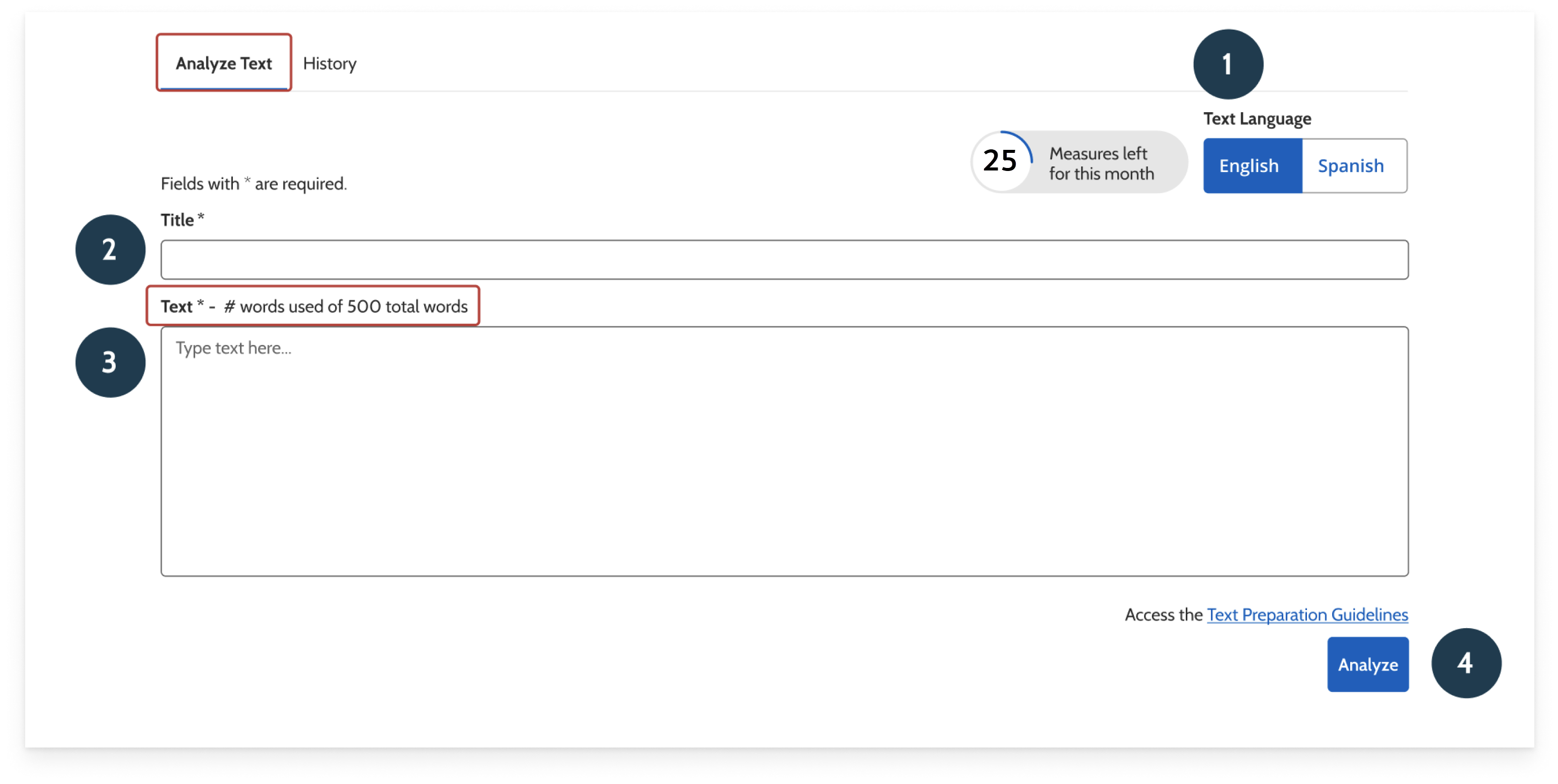
Begin on the Analyze Text screen:
- Select the text language, English or Spanish
- Enter a title for your text in the Title field. A title must be 255 or fewer characters. This is a required field and will be visible in the History tab.
- Paste or type your text into the Text field. (Required field). Note: The number of words available adjusts after you paste the text into the text box field or when you stop typing. If you exceed the 500 word count, you will receive an alert message and will be required to reduce the number of words to 500 or fewer.
- Ensure your text is properly prepared and edited, then select Analyze to receive the Lexile text measure range for your submission.
Measures Available per Month
Each month, the Premium membership allows educators to analyze a limited number of texts. Once the monthly allotment has been reached, users will no longer be able to submit a text for analysis until the first of the next month. Users can still view the history of previously analyzed texts. Use the Measures left for this month tracker to see your available measures.
Step 3: Analyze Additional Text
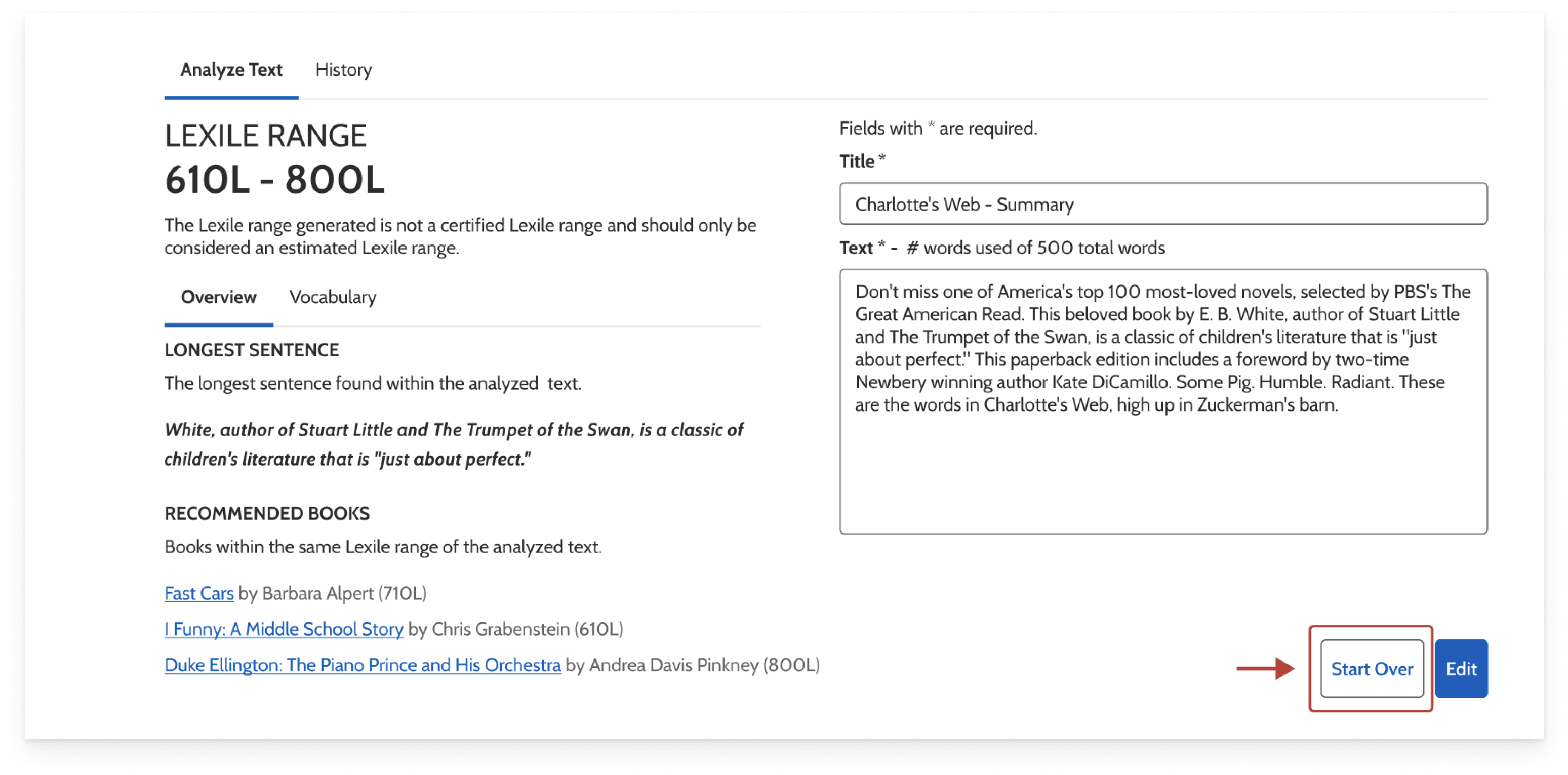
Step 4 (Optional): Edit Analyzed Text
Users can edit and resubmit analyzed text to fix errors or create versions at varying Lexile ranges to meet the needs of students.
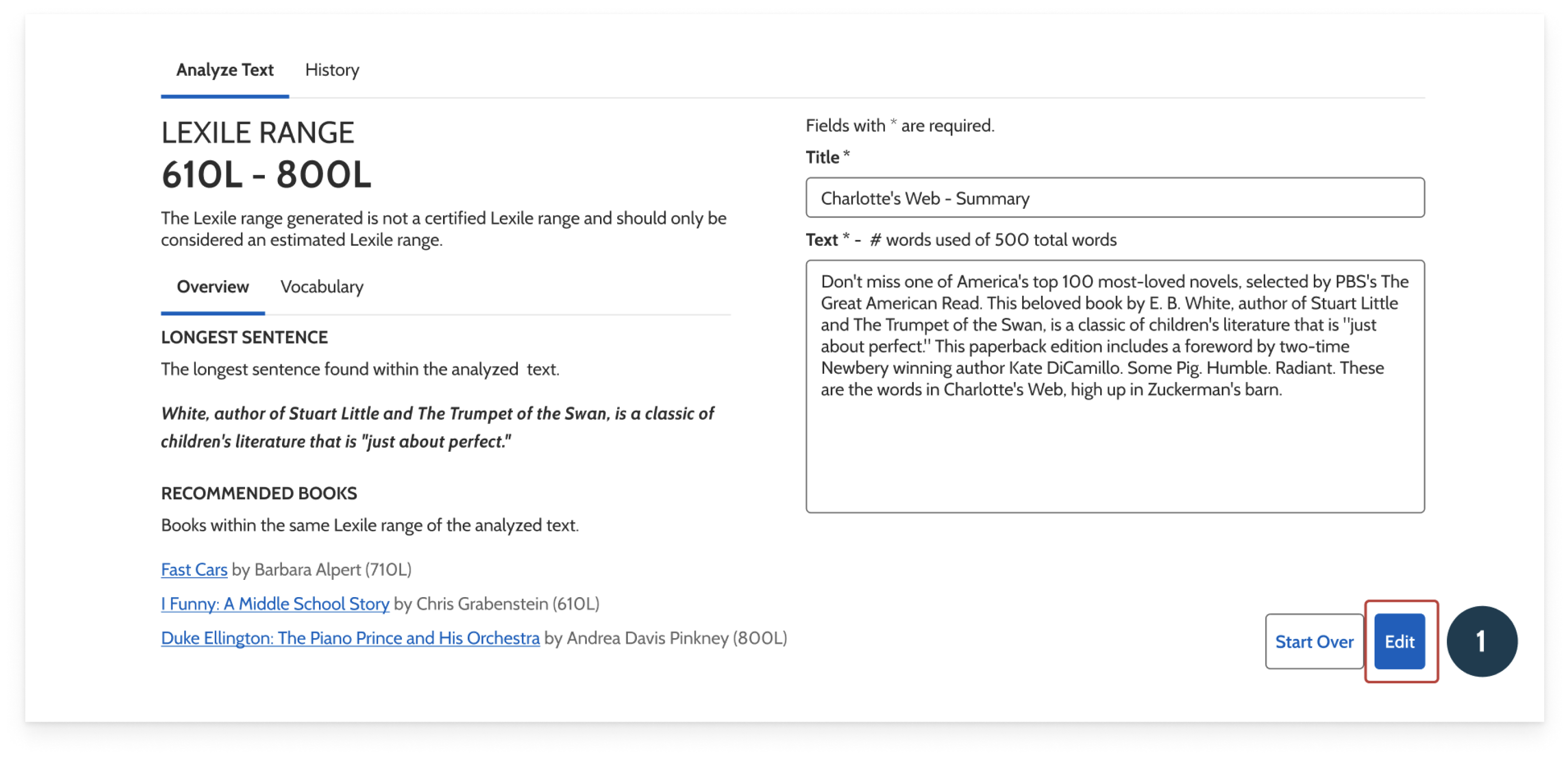
To edit the submission:
- Select the Edit button in the lower right corner of the Results page. This will take you back to the Analyze Text page.
- Text field and to the Title (to distinguish between the original and edited versions).
- Analyze to view the new results.
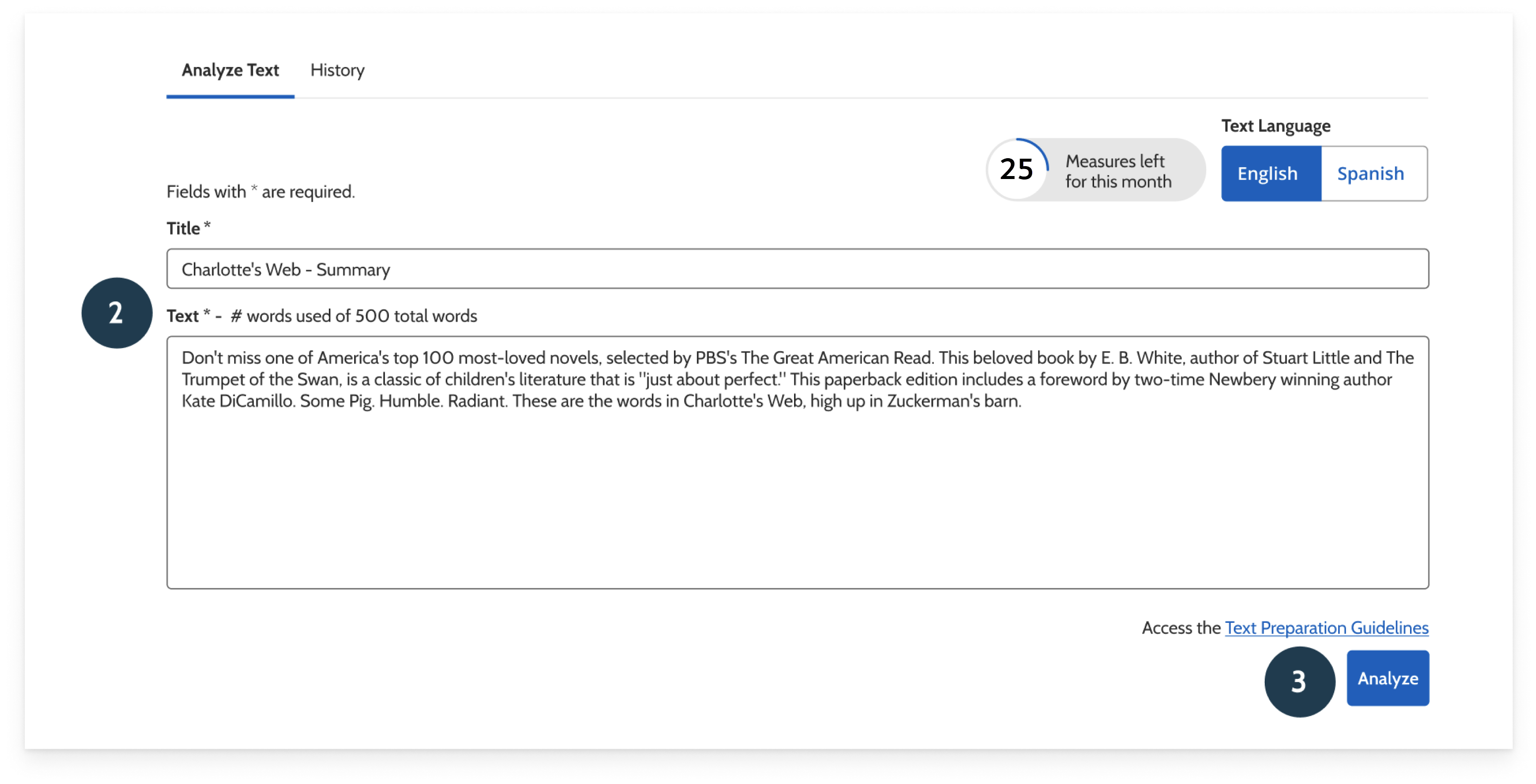
Step 5: View Analyzed Text Submission History
The Text Analyzer stores all text analyses.

- Select History at the top of the page.
- View Text Analyzer History by:
- Title
- Text
- Lexile Range
- Word Count
- Text Language
- Last Analyzed
- Use the up and down arrows to sort the list according to the different areas noted above.
- Select on the title of a submission to view the submission and the results.


Step 6: View and Interpret Results
Analysis results include a Lexile range, longest sentence, recommended books, and consequential vocabulary.
Lexile Range
- The Text Analyzer generates an estimated Lexile measure range to show the level of difficulty of the text.
- Lexile measures are expressed as numbers followed by an “L” (for example, 850L) and range from below 0L for beginning readers and text to above 1600L for advanced readers and text.
- Comparing a student’s Lexile measure with the Lexile measure range of what they are reading helps gauge the “fit” between a student’s ability and the difficulty of the text.
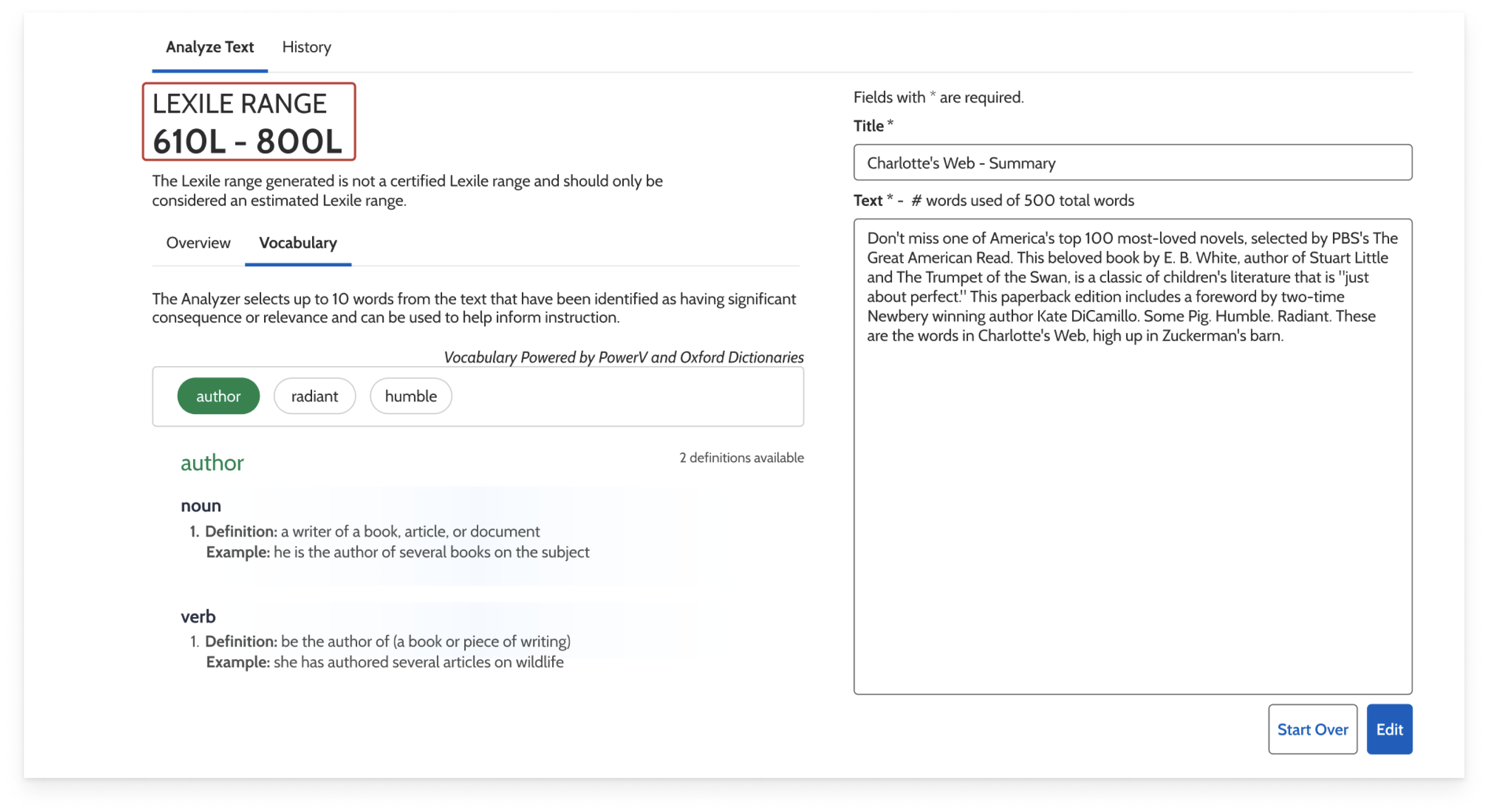
Overview
- The Overview section of the Results page will identify the Longest Sentence found and Recommended books within the Lexile range of the analyzed text.
- Click on any of the Recommended book titles to view the book’s detail page in Find a Book. (Find a Book is a tool that allows you to search for books in both English and Spanish using Lexile measure, grade level, or interests. For more information, view the Find a Book User Guide.)

Vocabulary (for English text only)
Select Vocabulary to display up to 10 words that have significant consequence or relevance. These are useful for pre-teaching to facilitate greater comprehension. Select the vocabulary word to see:
- the number of definitions available for that word (located in the right corner of the definition space)
- the part of speech, definition, and example of the word used in context
How to Apply Results in the Classroom
Identify Texts that are at an Appropriate Difficulty Level for Students
Analyze various classroom reading material (textbook unit introductions, articles, passages, assignments, etc.) to identify if the Lexile text measure is appropriate for students’ independent practice.
Modify the Text Difficulty to Make It More Appropriately Challenging for Students
Modify content, such as sentence combining or removing, and resubmit text to create a different version or versions within the Lexile range of your students for differentiated instruction and optimal comprehension. Knowing the Lexile text measure of reading material helps educators determine what types of support may be needed for students during instruction.
Scaffolding Vocabulary Instruction
View the consequential vocabulary words from your text analysis and determine which words might be challenging for your students. Scaffold vocabulary instruction using the parts of speech, definitions and examples provided from the analysis to set your students up for success.
Adjust Reading Comprehension Demands to Ensure Classroom Assessments Target Content Knowledge Instead of Reading Comprehension
Educators may find it helpful to evaluate the reading demand of the assessments they develop for classroom use. Getting an estimated Lexile text measure range for the overall assessment can provide insight into whether reading challenges are likely to affect student performance on the assessment. If the reading demands of the assessment are substantially higher than the Lexile measure of the student, a poor performance on the assessment may be due to reading comprehension issues rather than a sign of weak content knowledge. (For more information on what and how to measure assessments, go to the Special Use Case section in the Text Preparation Guidelines.)
FAQs
| Why did I receive a Lexile range instead of a specific Lexile measure? | The measure generated from the Lexile Text Analyzer is not a certified Lexile measure. Only trained MetaMetrics’ staff can certify a Lexile measure using the Lexile® Text Analyzer Content Creator. The Text Analyzer generates an estimated Lexile measure range to show the overall level of difficulty of the text. |
| What are Plain Text files, and how do I use them? | Plain text (.txt) is a type of digital file that is free of computer tags, special formatting, and code. This is the only file type recognized by the Lexile Text Analyzer. Note: Copying and pasting text other than plain text can cause inaccurate measurement of the text. |
| How can I use the Lexile Text Analyzer to assess the complexity of tests I develop? | When measuring reading comprehension tests, all complete sentences in all reading passages should be measured all together as one document when possible (if over the 500 word limit, measure the reading passages individually). You should not measure sample items, directions, or the test items themselves. Depending on the format of the test item, you may also measure the complete sentences in the items in order to compare their difficulties to those of the reading passage, but do not measure the item text together with the passage text. |
| How can I use the Lexile Text Analyzer to assess the complexity of web resources? | When measuring text from websites, be sure to remove the non-prose and web page-specific elements. Embedded computer tags, special formatting, and code are often present in web content. The Lexile Text Analyzer cannot recognize many of the elements, which can result in a computing error. Be sure to use plain text, txt.files, and remove any odd characters before selecting Analyze. |
